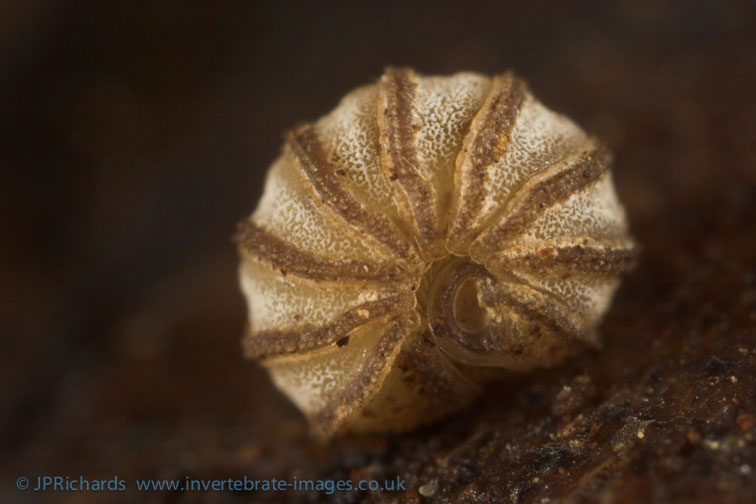Trachysphaera lobata (Ribaut, 1954)
Status:
- GB IUCN status: Vulnerable
- GB rarity status: Nationally Rare
ID Difficulty
Identification
The pill millipedes, Glomeridae, are distinctive short stout millipedes that are able to roll into a defensive ball when disturbed. When adult they have just twelve arched body tergites (including the collum and the telson) bearing 17 (female) or 19 (male) pairs of legs.
Trachysphaera lobata is a small pallid pill-millipede rolling into a ball of no more than 3 mm in diameter. The posterior margin of each body segment is raised into a distinct ridge bearing rows of tubercles and it has eyes comprising a row of 4-5 ommatidia (the superficially similar Adenomeris gibbosa and Geoglomeris subterranea are blind).
A description of this species, with figures, is provided by Jones and Keay (1986).
Taxonomic study, including molecular analysis and morphological comparisons, is summarised by Read, Lee, Wesener & Wilbrandt (2023).
Distribution
The first British records of this species are from two sites near Bembridge on the Isle of Wight in 1984 (Jones & Keay, 1986). Intensive searches of other, apparently suitable, sites on the Isle of Wight have failed to discover the species and one of the original sites has since been lost to development. The remaining site comprises a narrow belt of sycamore woodland at the base of soft earth cliffs. In 2007 two locations were found in south Wales (Harper, 2010) and in 2019 it was found in a mine in Cornwall (BMIG Newsletter 38, pg 5)
Elsewhere in Europe it is known only from a small number of calcareous sites in western France, mainly in caves, and from woodlands and a quarry near Paris (Kime, 2001).
Habitat
At the Bembridge site the species is found within a few metres of the high water mark in fallen dead wood, leaf litter and soil. Although the soil is mainly clay the millipedes are only found within pockets of sandy, humus rich soil. Jones and Keay (1986) found the species was most abundant at depths of c. 15 cm in these sand pockets where densities were equivalent to 5,600 m sq. An account of the ecology of the species is given by Read, Lee, Wesener & Wilbrandt (2023).
Phenology
Although it is unknown in the French populations, Bratton (1991) suggested that the British populations of T. lobata may be parthenogenetic. However, a male to female sex ratio of 1:3 was found for a sample of specimens collected from the British population in 2005 (Lee et al., 2005).
References
Bratton, J.H. (ed.) 1991. British Red Data Books: 3. Invertebrates other than insects. Peterborough: JNCC.
Jones, R.E. & Keay, A.N. 1986. Trachysphaera lobata (Ribaut), a millipede new to Britain, from the Isle of Wight. Bulletin of the British Myriapod Group, 3, 17-20.
Kime, R.D. 2001. The continental distribution of British and Irish millipedes, part 2. Bulletin of the British Myriapod and Isopod Group, 17, 7-42.
Lee, P., Gregory, S.J., Keay, A.N. & Read H.J. 2005. Report on a survey of the pill millipede Trachysphaera lobata (Ribaut, 1954) in the Bembridge area of the Isle of Wight. Unpublished report for English Nature.
Links
MilliBase - Global catalogue of Millipedes: https://millibase.org/aphia.php?p=taxdetails&id=1025774
More information about Trachysphaera lobata here









